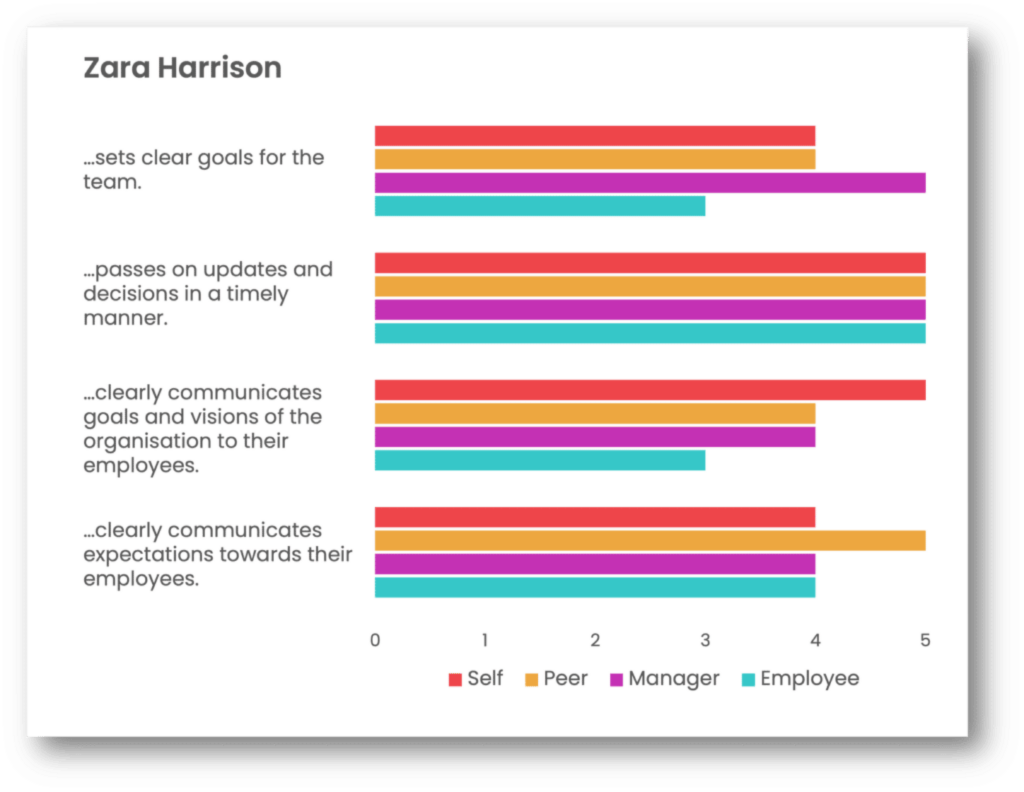Table of Contents
How to work with 360 degree feedback: Definition, variations, and advantages
360 degree feedback has become a valuable staple in any effective feedback system. In this article, we’ll have a look at what exactly 360° feedback is, which variations exist, and how you can use it to your advantage. By making use of it, you can improve your employee experience and the performance of your company, and in order to do that effectively, we’ll outline when the best time to do it is, as well as what themes to cover and what to avoid in your surveys. Finally, we’ll tackle the question of how to analyse and implement the results you have gained in a fruitful manner.
Table of contents
- Create surveys based on our templates
- Send surveys via email, links, API or individual logins
- Analyse responses with filters & AI
What is 360 degree feedback?

360 degree feedback allows you to evaluate managers at four different levels. Your leaders are the focus. They are not only reviewed by their managers but also by colleagues and the team they lead. Managers also take a closer look at themselves through self-assessment.
Do you want to take your 360 degree feedback a step further? Bring in external perspectives from customers and suppliers to get a broader view. This isn’t just about internal feedback; it’s about creating the whole picture.
Why use 360 degree feedback?
The goal of 360° feedback is to get a comprehensive overview of the leadership qualities of your managers and is part of the employee experience. It’s valuable for the individual managers and their personal development and their professional development, but also for the company as a whole. Through the assessment, you help leaders to become aware of their strengths and weaknesses and their effect on others. This allows them to develop in a targeted manner. It therefore also increases overall employee satisfaction and engagement. Thus, 360 degree feedback has already become a key tool in management development and employee satisfaction across many organisations.
Download our ebook for a detailed guide on 360-degree feedback.
Which variations are there for 360-degree feedback?
Each 360º feedback process can be adapted to suit individual managers and their personal objectives. This means you can choose how many different perspectives to include and create different variations of the process. Topics you can cover with 360 degree feedback include leadership skills, communication, performance and accountability, collaboration, work process, and more.
90 degree feedback (bottom-up feedback)
With bottom-up feedback, managers receive assessments exclusively from their direct reports. Here, managers undergo evaluation solely from those colleagues who report to them, creating a feedback flow from the ‘bottom’ to the ‘top.’
180 degree feedback
Building upon the bottom-up feedback, 180 degree feedback adds another layer to the by introducing a manager self-assessment. This expanded evaluation process, offers a nuanced comparison between self-perception and external viewpoints.
270 degree feedback
A 270 degree survey involves gaining three types of feedback. The three levels being feedback from the manager’s manager, feedback from their employees or subordinates, and finally they will also carry out a self-assessment.
360 degree feedback
The final level to complete the 360 degree feedback evaluation is feedback from colleagues at the same level as the manager in question. All of the levels together create the whole 360 degree feedback picture.
What are some relevant themes?
In order to be able to provide your managers with comprehensive and meaningful results, you must set up a high-quality 360 degree feedback questionnaire. Possible topics to cover include:
- General leadership skills
[The manager] recognises the performance of his/her employees. - Social skills
[The manager] is open to constructive feedback. - Information & Communication
[The manager] communicates expectations to direct reports in an understandable way. - Empowering others
[The manager] gives his/her direct reports the opportunity to take responsibility.

When is the best time for a 360° evaluation?
There are a variety of theories about where and when it is best to do a 360 evaluation. Many companies integrate it into a developmental review every six months, often coupling it with a 360-degree survey aligned with the salary review. On the flip side, others believe that if you conduct 360 assessments on an ongoing basis, everyone benefits.
New employees in particular benefit from repeated feedback sessions because they actively facilitate development. More frequent feedback means you get to really understand the core of the problem. You can tailor your insights to specific projects, customers, or incidents within the company.
The less frequently feedback you collect feedback, the more attention is required when interpreting the results. If feedback is only collected once a year, it might only reflect current conditions that don’t necessarily reflect normal conditions or the average perception of the workforce. More regular feedback, however, provides a more realistic overall picture of the manager’s impact through several measurement points.
How companies are using 360 degree feedback
It makes sense to use 360° feedback software to integrate the evaluations into your overall feedback system. You can incorporate it into your wider performance management and development plan, for instance, by linking it to performance reviews.
For example, the Munich Leadership Group are using Netigate as part of their development plan at executive level. They are using tailor-made 360 questionnaires from Netigate to tease out challenges and strengths in their management and leadership suite to create sustainable change. After each evaluation MLG are using their insights from the data obtained to create actionable measures and training opportunities. This is streamlined with the human resources department to make the feedback available for quick and easy implementation. In addition MLG is using Netigate for training evaluation surveys and pulse surveys.
What to consider when doing 360 feedback
Avoid posing questions that draw comparisons between different employees, as this approach can be counterproductive. Even when the feedback is positive, the comparative tone can be harmful. These types of questions can create rivalry and a lack of motivation among your workforce. Ensure that your questionnaires steer clear of vague, generalizing, or sexist inquiries and statements. Instead, focus on seeking concrete facts and frame your questions in an unbiased tone for more effective and fair feedback.
How to effectively use the results
In order to achieve lasting effects from your 360 degree feedback processes, you have to openly discuss your findings, contextualise and reflect on them. Your employees’ performance will benefit from receiving feedback if you discuss it with care and combine it with a plan for development.
After group and individual discussions, sensible measures for further action should be planned with those who gave feedback. This is the only way for your employees to see that their feedback really matters and that it is influencing positive change in the company towards a sustainable work culture.
Conduct a 360 degree evaluation with Netigate
Are you aware of your own strengths and weaknesses and those of your employees? If not, it is difficult to know what is required for the development of the company. With Netigate you get access to professional 360-degree feedback software that will help you to collect actionable insights for professional development.
Read more about 360-degree feedback and employee surveys or start your free Netigate trial today.
-
Helena Bjorkman
-
Helena Bjorkman
- 5 min read
- .







 Copyright © 2025 Netigate AB, Drottninggatan 25, 111 51, Stockholm, Sverige
Copyright © 2025 Netigate AB, Drottninggatan 25, 111 51, Stockholm, Sverige